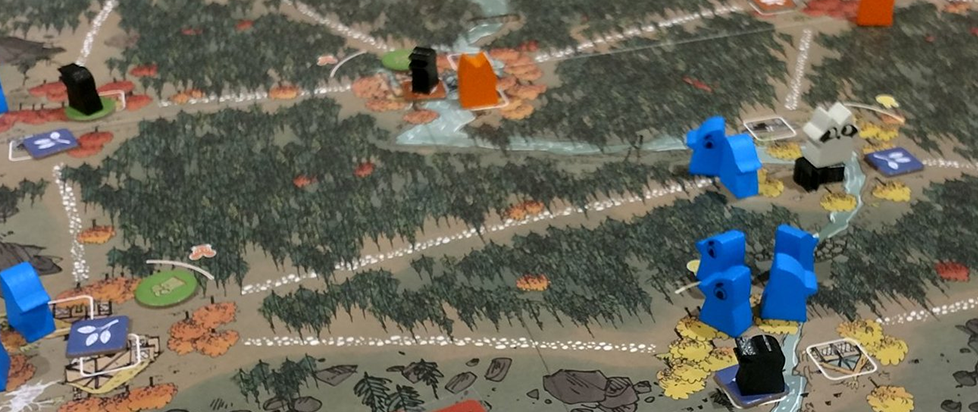
In the Trenches with Root
The Woodland Alliance spoke to my heart immediately. This emerald-green-clad assembly of common working critters pushed too far are experts at fomenting revolt and goading their enemies into guerrilla warfare, scooping up victory points in an unorthodox and indirect fashion. I slid right into a feigned helplessness, insisting that I was merely agitating for my rights as the collective of mice, rabbits, and foxes held under the thumb of the cats.
Yet, describing any one faction of the crowdfunded smash Root, a board game that until recently could hardly stay stocked online and at cons, only gives a fraction of the game’s experience. Each of the four main armies are themed and play almost completely differently, with crafting, cards, and action phases (Birdsong, Daylight, and Evening) being the central similarities between them. There’s the aforementioned antifa Woodland Alliance, the current feline overlords the Marquise de Cat, the deposed Eyrie that seeks to reclaim their lost glory, and the slippery Vagabond who purports to aid any of the other factions but is often pitting them against each other to her own advantage. A forest full of adorably lethal animals is locked in war, and while victory points are the condition by which any player is triumphant over the others, there is a variety of ways to cobble those points together.
Where Root delightfully succeeds is melding the central conceits of territorial control games like Risk with resource management sims like Settlers of Catan, all blended with the exceptional art of illustrator Kyle Ferrin bringing in a whiff of Mouse Guard. Where the alliance uses subterfuge, the cats are a more traditional setup of get stuff, spend stuff, all to maintain map control with a ruthlessness that their adorable eyes fuzzy faces doesn’t immediately betray. Playing the Marquise is more familiar, but that doesn’t mean they have a clear path to victory at every play through—the map is deceptively large, and controlling the entire thing while maintaining controlled connections to ferry your lumber takes a fair amount of foresight and anticipation of your enemies.
Each faction works completely asymmetrically from the others in this regard, even if most of their aims are similar—whether it’s building bases or workshops, demanding payment for movement to clearings or crafting items just to have a wandering raccoon foist them from you (with fair recompense, of course). The Eyrie is one of the more distinct systems, as the birds are constantly adjusting a script they absolutely must follow, from moving, recruiting warriors, constructing roosts, and initiating battles with increasingly elaborate guidelines. If this script can’t be followed they go into turmoil, switching leaders and central abilities, losing cards, and slowing down their board state a little bit. But this extreme change in leadership can be a boon, almost as beneficial as when your decree hums along at peak efficiency, assuming you can ride the wave effectively.
There’s a tint of four-games-in-one here, which could easily devolve into communal solitaire if there wasn’t constant negotiation, collusion, and direct combat between the players and their factions. On top of that, it’s initially quite easy to forget a lot of things, as there’s a lot going on with in Root and many rules to keep track of. By the second game the systems arrange themselves in each player’s mind and the learning curve flattens out, and each side might be tempted to nurse their own little corner of the map. But the one that remembers victory points scored for battles won or enemy tokens forcibly removed can really amp up the tension and interactivity. And there’s always the wildcard vagabond, who carries a penchant for sowing discord and operates according to her own whims and missions, which might incline the other players to cut her out if not for the fact that crafting items for her grants points for themselves as well.
Each faction’s complexity threatens lull the player into a self-defeating myopia, giving the vagabond an edge by crafting too many items, getting separated off from their lumber supply by not protecting the lanes of transit, or neglecting an unwieldy decree too early. Though tracking one’s own modus operandi while anticipating whatever the other three combatants sounds potentially overwhelming it really does settle in with the help of an engaging aesthetic that keeps the player zoned it. Each card brims with colorful life, laying out each team as a visually distinct trove of tokens, leaders, suits, and potential abilities. It’s cute but cutthroat, initially overwhelming but ultimately just the right serving of strategy and sketched out scenery.
I’ve played Root with experienced board gamers and wide-eyed initiates and each of them catch on quickly enough, toughing out the tricky first few rounds to keep up with the fantastic dressing and multitude of play styles. And with four almost totally distinct methods of wreaking havoc, there’s a setup for every mood, whether you’re looking for something fresh or familiar. This balance is where Root stitches up woodland war into a wonderful quilt, each square distinct yet threaded together impeccably.





